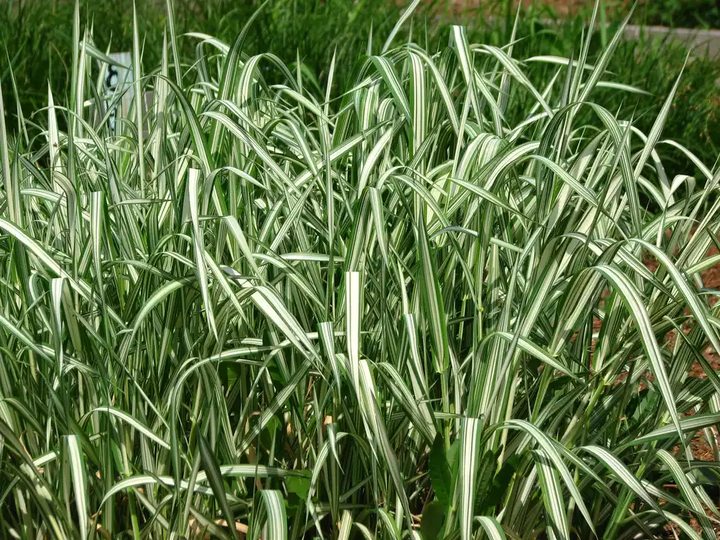Phalaris arundinacea, more commonly known as Reed Canary Grass, is a tall-growing bunchgrass. It's often found beside rivers, streams, ponds and wetlands in its native habitat.
One of the most common cultivars of this species is Ribbon Grass (Phalaris arundinacea var. picta). This is an ornamental grass variety with eye-catching variegated foliage that can work well as a tall, textured and interesting ground cover.
Although Ribbon Grass can occasionally flower, it's the foliage that makes this plant. The blooms aren't of any great significance. This cool-season grass grows in the spring and fall but can go dormant during the summer months.
In sunny sites, with consistent moisture, this plant thrives. In fact, it spreads incredibly easily and quickly. For this reason, it won't be suited to every garden. Ribbon Grass can quickly overtake small spaces, and some states even class this species as an invasive and noxious weed. It will work, however, being grown contained in pots or being used as a dramatic mass planting option.
It can grow in wet, boggy conditions around ponds and can stabilize river bank edges or slopes. It's best to select it for those purposes when nothing else will grow. Otherwise, it could choke out other established species with its strong spreading rhizomes. This hardy grass can also grow in dry, desert gardens, and these conditions will limit its spread considerably.
Botanical Name:
Phalaris arundinacea var. 'Picta'.
Common Name:
Ribbon Grass
Plant Type:
Perennial ornamental grass
Mature Size:
Up to 3 feet
Sun Exposure:
Full sun/partial shade
Soil Type:
Tolerant of a variety, but must be well-drained
Soil pH:
Tolerates a variety
Bloom Time:
Summer
Flower Color:
White or pink, but it is rare for them to flower
Hardiness Zones:
4 to 9
Native Area:
Europe and North America
How to Grow Ribbon Grass
A versatile, robust plant, Ribbon grass will grow in most soil types and can also handle standing water or dry conditions. It's a low-maintenance species, and it isn't prone to disease or pest infestations.
Light
Ribbon Grass thrives in partial shade locations. It can also cope in full sun, but if the summer heat is intense, then leaf scorch can occur. A partial shade location also means that the spread of this plant is less intense, and it's less likely to choke out other plants.
Soil
One of the advantages of Ribbon Grass is that it tolerates a wide variety of soils. It can cope in dry, infertile soils, clay and sand. It isn't fussy about pH levels either. The one thing it does like is for the soil to be well-drained.
Water
Ribbon Grass prefers moist soils, but this robust plant can still survive in standing water and when conditions are dry. If you want to limit the spread of Ribbon Grass, keeping conditions drier can help. When you're using this species as a stabilizer or a fast-spreading ground cover, you will want to keep it well watered to encourage speedy growth.
Temperature and Humidity
This hardy grass can cope with a wide variety of conditions. As already mentioned, intense heat can lead to leaf scorch. Frost can also lead to damage to the leaves. It's a good idea to protect the roots with mulching in winter if you experience colder conditions.
Fertilizer
Ribbon Grass doesn't need regular feeding to thrive. However, if your plants have suffered from leaf scorch during a hot summer, using a weak fertilizer solution can encourage new and healthy growth.
Propagating Ribbon Grass
The seeds of Ribbon Grass are sterile. However, it has fast-spreading rhizomes. It's easy to propagate from these in the spring or fall. You can also create new plants by dividing healthy clumps in the spring.
Pruning
Taking off the top of the growth in early spring will encourage new and healthy growth to appear. If you want to see additional growth in the fall, pruning back the foliage of your Ribbon Grass during the summer months again is also recommended. Pruning also helps to retain the striking variegate pattern on the grass.
You Might Like ...